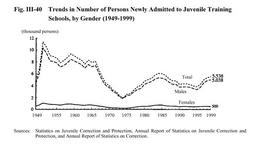| Previous Next Index Image Index Year Selection | |
|
|
2 Admission and discharge (1) Admission
Trends in the number of persons newly admitted to juvenile training schools since 1949are shown in Fig. III-40. Newly admitted juveniles decreased gradually from1985but have been increasing since 1996(see Appendix III-13 ). Fig. III-40 Trends in Number of Persons Newly Admitted to Juvenile Training Schools, by Gender(1949-1999) 5,538juveniles were newly admitted in1999,up2.8%from the previous year. The average number of juveniles detained per day stood at4,198,up7.2%. Table III-7 breaks down this number by type of juvenile training school and treatment(see Appendix III-14 ).Table III-7 Composition of Persons Newly Admitted to Juvenile Training Schools, by Type of School and Treatment(1999) (2) Discharge 5,391persons were discharged from juvenile training schools in1999,of whom96.2%(5,187persons)were released on parole.36.4%of those discharged found jobs,42.4%were seeking employment,10.2%wished to enter schools at higher levels,1.9%returned to junior high schools and2.1%returned to senior high school. Only6.0%were discharged with no prospects for subsequent education or employment. The average detention period of those released on parole was377days for long-term treatment,149days for general short-term treatment, and81days for special short-term treatment(source:Annual Report of Statistics on Correction). |

